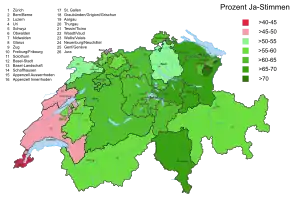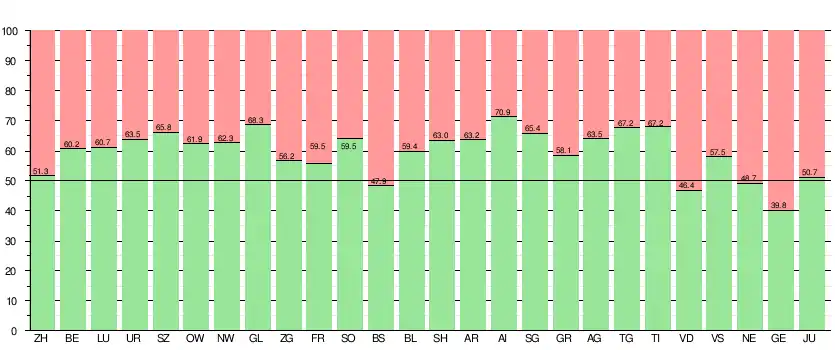| This article is part of a series on the |
.svg.png.webp) |
|---|
|
|
Eight referendums were held in Switzerland during 2009. The first was held on 8 February on extending the freedom of movement for workers from Bulgaria and Romania. The next two were held on 17 May 2009 on introducing biometric passports and the "Future with complementary medicine" proposal. A further two were held on 27 September on increasing VAT and the introduction of public initiatives. The final three were held on 29 November on banning the construction of new minarets, exporting weapons and the use of aviation fuel taxation.
February referendum
The February referendum was held on extending the freedom of movement for workers within the European Union to Bulgaria and Romania, who joined the EU on 1 January 2007, and on removing the sunset provision from the agreement. If Swiss voters had rejected the continuation and extension, the EU would likely have invoked the so-called "guillotine clause" to terminate all agreements made as part of the bilateral treaties.[1]
A poll from January 2009 saw 49% in favour of extending the agreement, 40% opposed and 11% undecided; 48% of voters said they would participate in the referendum.[2]
The referendum concluded with a vote in favour of the extension, with German and French-speaking cantons mostly voting in favour (except for narrow votes against in Schwyz, Glarus and Appenzell Innerrhoden) and the Italian-speaking Ticino strongly voting against.[3]
The result caused the left-wing Green Party and the Social Democratic Party to state that they would renew their push for Swiss EU membership.[4]
| Choice | Votes | % |
|---|---|---|
| For | 1,517,132 | 59.61 |
| Against | 1,027,899 | 40.39 |
| Invalid/blank votes | 27,009 | – |
| Total | 2,572,040 | 100 |
| Registered voters/turnout | 4,999,618 | 51.44 |
| Source: Direct Democracy | ||
May referendums
The two referendums in May concerned:
- approval of the introduction of biometric passports
- a proposal "Future with complementary medicine" (Zukunft mit Komplementärmedizin)
The biometric passport introduction approval was accepted with a slim majority, with 50.15% in favour of the proposal; the complementary medicine proposal was accepted with 67.0% in favour. Turnout was 39%.
Biometric passports
| Choice | Votes | % |
|---|---|---|
| For | 953,173 | 50.15 |
| Against | 947,493 | 49.85 |
| Invalid/blank votes | 42,191 | – |
| Total | 1,942,857 | 100 |
| Registered voters/turnout | 5,010,873 | 38.77 |
| Source: Direct Democracy | ||
Complementary medicine
| Choice | Public vote | Cantons | |||
|---|---|---|---|---|---|
| Votes | % | Full | Half | Total | |
| For | 1,283,894 | 67.03 | 20 | 6 | 23 |
| Against | 631,560 | 32.97 | 0 | 0 | 0 |
| Invalid/blank votes | 28,805 | – | – | – | – |
| Total | 1,944,259 | 100 | 20 | 6 | 23 |
| Registered voters/turnout | 5,010,873 | 38.80 | – | – | – |
| Source: Direct Democracy | |||||
September referendums
The September referendum put two questions to voters:[5]
- a limited increase of VAT to continue financing the Invalidenversicherung (Disability Insurance)
- accepting the decision not to introduce allgemeine Volksinitiativen (public initiatives) (which has been deemed impossible for procedural reasons)
VAT increase
| Choice | Public vote | Cantons | |||
|---|---|---|---|---|---|
| Votes | % | Full | Half | Total | |
| For | 1,112,818 | 54.56 | 11 | 2 | 12 |
| Against | 926,730 | 45.44 | 9 | 4 | 11 |
| Invalid/blank votes | 23,580 | – | – | – | – |
| Total | 2,063,128 | 100 | 20 | 6 | 23 |
| Registered voters/turnout | 5,030,915 | 41.01 | – | – | – |
| Source: Direct Democracy | |||||
Public initiatives
| Choice | Public vote | Cantons | |||
|---|---|---|---|---|---|
| Votes | % | Full | Half | Total | |
| For | 1,307,237 | 67.88 | 20 | 6 | 23 |
| Against | 618,664 | 32.12 | 0 | 0 | 0 |
| Invalid/blank votes | 108,192 | – | – | – | – |
| Total | 2,034,093 | 100 | 20 | 6 | 23 |
| Registered voters/turnout | 5,030,915 | 40.43 | – | – | – |
| Source: Direct Democracy | |||||
November referendums

In the November referendum voters decide on three proposals on the federal level:[6]
- a ban on the construction of new minarets (without retroactive effect on four existing Swiss minarets), passed with 57% in favour; The referendum took place following a campaign to ban minarets in the country.[7]
- a ban on exporting matériel (war supplies), rejected with 68% against;
- a prescription that money collected from aviation fuel taxation should be used for aviation matters, passed with 65% in favour.
There were numerous other issues voted upon at the cantonal and municipal levels.
Minaret ban
Only one political party, the right wing Swiss People's Party supported the referendum. Pakistani newspaper The Nation on 30 January 2010 carried a fabricated story according to which "the first man who had launched a drive for imposition of ban on mosques minarets" had seen the error of his "evil ways" and had converted to Islam, which had supposedly "created furore in Swiss politics", claiming that Streich "is ashamed of his doings now and desires to construct the most beautiful mosque of Europe in Switzerland."[8] Tikkun Daily on 5 February debunked The Nation's story as a distorted version of a report on Daniel Streich, a Swiss Muslim who left the Swiss People's Party because he was outraged with their campaign.[9]
Final results showed 57.5% of voters in favour of the ban, 19.5 cantons out of 23 in favour of the proposals.[10]
| Choice | Public vote | Cantons | |||
|---|---|---|---|---|---|
| Votes | % | Full | Half | Total | |
| For | 1,535,010 | 57.50 | 17 | 5 | 19.5 |
| Against | 1,134,440 | 42.50 | 3 | 1 | 3.5 |
| Invalid/blank votes | 39,837 | – | – | – | – |
| Total | 2,709,287 | 100 | 20 | 6 | 23 |
| Registered voters/turnout | 5,039,676 | 53.76 | – | – | – |
| Source: Direct Democracy | |||||

Key to above graph:
- Horizontal axis: abbreviations of Swiss cantons
- Red: percentage opposed to ban
- Green: percentage supporting ban
Arms export
The arms referendum sought to ban the export of military weapons and ammunition, in order to further reduce Switzerland's involvement in war. Current law prohibits the exports of materiel to countries involved in armed conflict, or violating human rights. The Swiss arms industry warned of possible job losses if passed, and the cabinet recommended against it saying that existing legislation offers enough protections. The group backing the initiative argued that weapons exports contradict the country's neutrality. A similar initiative was defeated in 1997.
Voters rejected the proposal by 68.2%, with 31.5% in favour of the measure. Turnout was 53%.[11]
| Choice | Public vote | Cantons | |||
|---|---|---|---|---|---|
| Votes | % | Full | Half | Total | |
| For | 837,156 | 31.77 | 0 | 0 | 0 |
| Against | 1,798,132 | 68.23 | 20 | 3 | 23 |
| Invalid/blank votes | 55,200 | – | – | – | – |
| Total | 2,690,488 | 100 | 20 | 6 | 23 |
| Registered voters/turnout | 5,039,676 | 53.39 | – | – | – |
| Source: Direct Democracy | |||||
Aviation fuel taxation
The aviation fuel tax referendum was initiated by centre-right and right members of parliament to direct much of the taxes on kerosene to airport spending. Previously two-thirds of the taxes collected were spent on road safety, with the rest going to the federal general fund. The initiative directs the two-thirds to aviation safety and environmental concerns, with the remainder continuing to be used for discretionary spending.[12]
Voters approved the measure with 65% in favour.[13]
| Choice | Public vote | Cantons | |||
|---|---|---|---|---|---|
| Votes | % | Full | Half | Total | |
| For | 1,609,682 | 64.99 | 20 | 6 | 23 |
| Against | 867,113 | 35.01 | 0 | 0 | 0 |
| Invalid/blank votes | 175,410 | – | – | – | – |
| Total | 2,652,205 | 100 | 20 | 6 | 23 |
| Registered voters/turnout | 5,039,676 | 52.63 | – | – | – |
| Source: Direct Democracy | |||||
Cantonal referendums
In the canton of Obwalden, the voting population turned down plans to reserve sections of land for the wealthy, officially designated "high quality standard of life zones of cantonal interest". These zones were part of Obwalden's strategy of increasing tax attractiveness in competition with other cantons. The referendum was successfully opposed by the cantonal section of the Swiss Green Party. Obwalden already has a flat tax system for the benefit of its rich residents, and attempted to introduce a regressive tax system, which was ruled unconstitutional by the Swiss Federal Court.[14]
References
- ↑ Beekman, Rene (2009-01-01). "Swiss federations urge for open labour markets". The Sofia Echo. Retrieved 2009-02-08.
- ↑ "Befürworter mit 9 Prozent Vorsprung". Neue Zürcher Zeitung (in German). 2009-01-09. Retrieved 2009-02-08.
- ↑ Hershman, Gabriel (2009-02-08). "Switzerland votes 'yes' in key labour market referendum". The Sofia Echo. Retrieved 2009-02-08.
- ↑ "Linke lanciert neue EU-Beitrittsdebatte" (in German). baz.online. 2009-02-08. Retrieved 2009-02-09.
- ↑ Swiss referendum September 27, 2009. IFES Election Guide.
- ↑ "Minarett-Initiative kommt Ende November vors Volk" (in German). NZZ. 1 July 2009.
- ↑ "Switzerland Approves Minaret Ban In Referendum". Radio Free Europe/Radio Liberty. 29 November 2009. Retrieved 29 November 2009.
- ↑ Swiss antagonist of minarets embraces Islam Archived 2013-07-03 at the Wayback Machine; The Nation; January 30, 2010,
- ↑ Minarets and the Conversion of a Swiss Politician: Separating Facts from Fantasy
- ↑ "Minaret ban wins Swiss support". Al Jazeera. 29 November 2009. Retrieved 29 November 2009.
- ↑ "Weapons export ban rejected by voters". Swissinfo. 29 November 2009. Archived from the original on 18 September 2013. Retrieved 29 November 2009.
- ↑ Regional airports to benefit from modified aviation fuel tax, supporters say - swissinfo
- ↑ "Unbestrittene Kerosinsteuer". NZZ. 30 November 2009. Retrieved 30 November 2009.
- ↑ Obwalden votes against rich "ghetto zone", swissinfo.ch 29 November 2009.